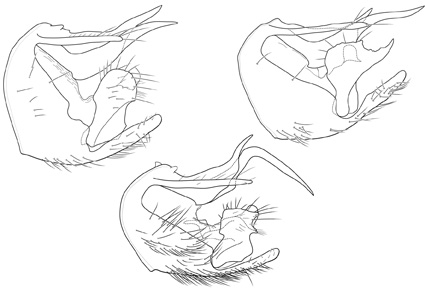Abstract
We examined adult specimens of the Mystacides azureus Species Group (Trichoptera: Leptoceridae) collected in Japan and confirm three species including M. azureus Linnaeus 1761 and two new species, M. rivularis and M. moritai. Males and females of the new species are described. Mystacides azureus in Japan is shown to have a considerable variation in morphology of the male tergum X. We analyzed mitochondrial COI barcodes of the genus Mystacides including these three species to confirm their species status. A maximum likelihood phylogeny based on COI barcodes shows monophyly of the new species. It also supports the hypothesis that morphological variation of the male tergum X in Japanese populations is intraspecific in only M. azureus.
References
- Berthold, A.A. (1827) Latreille’s natürliche Familien des Thierreichs, aus dem französischen, mit Anmerkungen und Zusätzen. Im Verlage des Gr. H.S. priv. Landes-Industrie- Comptoirs, Weimar, viii + 605 pp.
- Gullefors, B. & Petersson, E. (1993) Sexual dimorphism in relation to swarming and pair formation patterns in leptocerid caddisflies (Trichoptera: Leptoceridae). Journal of Insect Behavior, 6 (5), 563–577. https://doi.org/10.1007/BF01048123
- Hoang, D.T., Chernomor, O., Haeseler, A. von, Minh, B.Q. & Vinh, L.S. (2017) UFBoot2: Improving the ultrafast bootstrap approximation. Molecular Biology and Evolution, 35 (2), 518–522. https://doi.org/10.1093/molbev/msx281
- Kalyaanamoorthy, S., Minh, B.Q., Wong, T.K.F., Haeseler, A. von & Jermiin, L.S. (2017) ModelFinder: Fast model selection for accurate phylogenetic estimates. Nature Methods, 14 (6), 587–589. https://doi.org/10.1038/nmeth.4285
- Kimmins, D.E. (1963) On the Leptocerinae of the Indian sub-continent and north east Burma (Trichoptera). Bulletin of the British Museum (Natural History), Entomology, 14 (6), 261–316. https://doi.org/10.5962/bhl.part.8784
- Kumanski, K. 1988. Trichoptera, Integripalpia. Fauna Bulgarica 19. Bulgarska Akademi na Naukite, Sofia, 354 pp.
- Linnaeus, C. (1761) Fauna Svecia: Sistens Animalia Sveciae Regni: Mammalia, Aves, Amphibia, Pisces, Insecta, Vermes. Distributa per Classes & Ordines, Genera & Species, cum Differentiis Specierum, Synonymis Auctorum, Nominibus Incolaru, Locis Natalium, Descriptionibus Insectorum. 2nd Edition. Sumtu & Literis Direct. Laurentii Salvii, Stockholm, 578 pp., 2 pls. https://doi.org/10.5962/bhl.title.34906
- Malicky, H. (2012) Neue asiatische Köcherfliegen aus neuen Ausbeuten (Insecta, Trichoptera). Linzer Biologische Beiträge, 44 (2), 1263–1310.
- Martynov, A.V. (1924) Notice sur les Trichoptères de la district de Minoussinsk. Jahrbuch der Martjanovischen Staatsmuseums in Minoussinsk, 2 (3), 62–107. [Russian with English resumé]
- Minh, B.Q., Schmidt, H.A., Chernomor, O., Schrempf, D., Woodhams, M.D., Haeseler, von, A. & Lanfear, R. (2020) IQ-TREE 2: New models and efficient methods for phylogenetic inference in the genomic era. Molecular Biology and Evolution, 37 (5), 1530–1534. https://doi.org/10.1093/molbev/msaa015
- Morita, H. (2011) Shima-hanto no tobikera-rui [Caddisflies of Shima Peninsula]. In: Narukawa, N. (Ed.), Shima-hanto no Konchû (Insect Fauna of Shima Peninsula), Mie Konchû Danwakai, pp. 212–218. [in Japanese]
- Morse, J.C. (Ed.) (2022) Trichoptera World Checklist. Available from: http://entweb.clemson.edu/database/trichopt/index.htm (accessed 11 February 2022)
- Morse, J.C. & Yang, L. (2002) Phylogeny, classification, and historical biogeography of world species of Mystacides (Trichoptera: Leptoceridae), with a new species from Sri Lanka. In: Mey, W. (Ed.), Proceedings of the 10th International Symposium on Trichoptera. Goecke & Evers, Keltern, pp. 173–186.
- Mosely, M.E. (1939) The British Caddis Flies (Trichoptera). Routledge, London, 320 pp.
- Nozaki, T. & Tanida, K. (2007) The caddisfly fauna of a huge spring-fed stream, the Kakida River, in central Japan. In: Bueno-Soria, J., Barba-Álvarez, R. & Armitage, B.J. (Eds.), Proceedings of the 12th International Symposium on Trichoptera. The Caddis Press, Columbus, pp. 243–255.
- Vshivkova, T.S., Morse, J.C. & Yang, L. (1997) Family Leptoceridae. In: Lehr, P.A. (Ed.), Key to the Insects of the Russian Far East. Vol. 5. Part 1. Trichoptera and Lepidoptera. Dal’nauka, Vladivostok, pp. 154–202. [in Russian]
- Yamamoto, T. & Ross, H.H. (1966) A phylogenetic outline of the caddisfly genus Mystacides (Trichoptera: Leptoceridae). The Canadian Entomologist, 98 (6), 627–632. https://doi.org/10.4039/Ent98627-6
- Yang, L. & Morse, J.C. (2000) Leptoceridae (Trichoptera) of the People’s Republic of China. Memoirs of the American Entomological Institute, 64, 1–311.
- Zhou, X., Frandsen, P., Holzenthal, R.W., Beet, C.R., Bennett, K.R., Blahnik, R.J., Bonada, N., Cartwright, D., Chuluunbat, S., Cocks, G.V., Collins, G.E., deWaard, J., Dean, J., Flint, O., Gonzalez, M.R., Hausmann, A., Hendrich, L., Hess, M., Hogg, I.D., Kondratieff, B.C., Malicky, H., Milton, M.A., Morinière, J., Morse, J.C., Pauls, S., Rinne, A., Robinson, J., Salokannel, J., Shackleton, M., Smith, B., Stamatakis, A., StClair, R., Thomas, J.A., Zamora-Muñoz, C., Ziesmann, T. & Kjer, K.M. (2016) The Trichoptera barcode initiative: a strategy for generating a species-level Tree of Life. Philosophical Transactions of the Royal Society B: Biology Science, 371 (1702), 20160025. https://doi.org/10.1098/rstb.2016.0025


